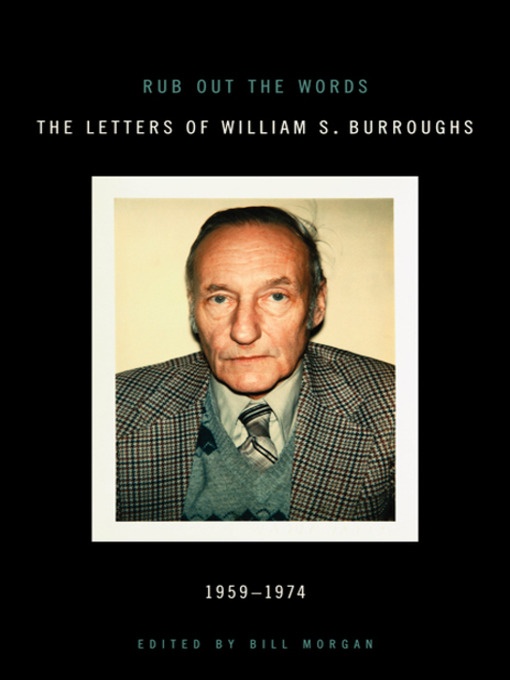
Rub Out the Words
The Letters of William S. Burroughs 1959-1974
فرمت کتاب
ebook
تاریخ انتشار
2012
نویسنده
Coleen Marloنویسنده
Lauryn Chunنویسنده
William S. Burroughsناشر
HarperCollinsشابک
9780062096777
کتاب های مرتبط
- اطلاعات
- نقد و بررسی
- دیدگاه کاربران
نقد و بررسی

November 28, 2011
Playful, obscene, engrossing at times, these 300 letters by Burroughs, from 1959, when The Naked Lunch (before the definite article was dropped) was issued in Paris, to 1974 when he accepted a teaching position at the City College of New York, cast a light on the writer’s eventful life. Edited by beat expert Bill Morgan (The Typewriter Is Holy), this volume picks up where 1993’s The Letters of William Burroughs, vol. 1: 1945–1959 left off. Of special interest is Burroughs’s work with surrealist painter and cutup artist Brion Gysin and the influence that visual method had on the writings. Through Burroughs, we catch glimpses of writers and figures as diverse as Anatole France, Timothy Leary, L. Ron Hubbard, Truman Capote, Carlos Castaneda, Frank Herbert, and Mario Puzo. Burroughs was no Scout Master, but in these letters, he comes across as reasonable and quite tame.

December 1, 2011
A continuation of the selected letters of the unique writer in the same format as editor Olivia Harris' The Letters of William S. Burroughs 1945–1959 (1993). Beat Generation expert Morgan (The Typewriter Is Holy: The Complete, Uncensored History of the Beat Generation, 2010, etc.) has assembled a representative selection from the 1,000-plus letters that Burroughs (1914–1997) wrote during the 15 years the collection comprises. Most are to three correspondents: his son, Billy; his friends and colleagues Allen Ginsberg and Brion Gysin. Billy, we learn through the letters, had adolescent troubles with drugs (are we surprised?), including several arrests--but by the end of these letters he was married and having some publishing success as William Burroughs Jr. Ginsberg's role as principal confidante was soon assumed by Gysin, to whom Burroughs wrote most frankly about everything from gay porn to drugs and Timothy Leary (whom he grew to revile) to philosophies of composition to books he liked (Dune, The Godfather) or despised (In Cold Blood). Included is a vicious letter Burroughs wrote in 1970 to Truman Capote, accusing Capote of betraying, even killing, his talent. Many of the letters deal with the process first employed by Gysin and then adopted and championed by Burroughs--the "cut-up" process. For years Burroughs was enamored of this technique of snipping passages from publications and pasting them up in novel arrangements. He tried the technique with photographs, motion pictures and audio recordings as well--all discussed at length in the letters. Burroughs also followed some complex choreography with scientology and L. Ron Hubbard, whom he later accused of creating a "fascist cosmos." Perhaps most surprising: Burroughs' phenomenal work ethic and assiduousness. Each letter is a window that permits a fresh view of a most complex and revolutionary writer.
(COPYRIGHT (2011) KIRKUS REVIEWS/NIELSEN BUSINESS MEDIA, INC. ALL RIGHTS RESERVED.)

February 1, 2012
In 1993, The Letters of William S. Burroughs, 1945-1959, edited by Oliver Harris, was published. Now we have the next volume, ably edited by Beat generation scholar Morgan (The Typewriter Is Holy: The Complete, Uncensored History of the Beat Generation). It contains over 300 subsequent letters written mostly to friends, family, and business associates between the publication of Naked Lunch and Burroughs's return to New York City to teach at City College. While old friends like Allen Ginsberg are among the recipients, more of the letters are addressed to newer companions whom Burroughs met while living abroad, including Brion Gysin, Paul Bowles, and Alex Trocchi. Many letters evidence Burroughs's obsessions with the cut-up method, Scientology, and the effectiveness of apomorphine as a cure for addiction; others reveal a caring father concerned about his son's well-being and financial security. Readers of these diverse letters will meet a writer intent on moving beyond his assigned role as a Beat icon. Morgan includes helpful explanatory notes, a chronology, and a list of sources identifying the repositories holding the letters. VERDICT Overall, the portrait of Burroughs that emerges from these pages is one of a professional writer striving to make a living without compromising his art. Highly recommended.--William Gargan, Brooklyn Coll. Lib., CUNY
Copyright 2012 Library Journal, LLC Used with permission.

























دیدگاه کاربران